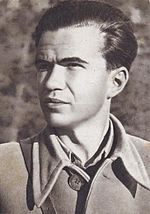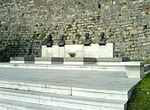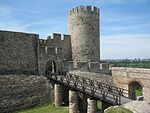Mehmed Paša Sokolović's Fountain

Mehmed Paša Sokolović's Fountain (Serbian: Чесма Мехмед-паше Соколовића, romanized: Česma Mehmed-paše Sokolovića) is an Ottoman era fountain in Belgrade. It is located next to the Defterdar's Gate near the northwestern wall of the Upper Town of Belgrade Fortress. Evliya Çelebi states that the fountain was erected in 1576/77, during the lifetime of Grand Vizier Меhmed Paša Sokolović and it is his only surviving endowment in Belgrade. The precise position of the fountain does not appear in any cartographic sources until the 17th century. The earliest sketch dates back to a plan from the National Library in Paris from the early 17th century, in which the fountain was presented as a rectangular structure with three free sides.
Excerpt from the Wikipedia article Mehmed Paša Sokolović's Fountain (License: CC BY-SA 3.0, Authors, Images).Mehmed Paša Sokolović's Fountain
Велико силазно степениште, Belgrade Old Town (Stari Grad Urban Municipality)
Geographical coordinates (GPS) Address External links Nearby Places Show on map
Geographical coordinates (GPS)
| Latitude | Longitude |
|---|---|
| N 44.824069 ° | E 20.449203 ° |
Address
Чесма Мехмед-паше Соколовића
Велико силазно степениште
11000 Belgrade, Old Town (Stari Grad Urban Municipality)
Central Serbia, Serbia
Open on Google Maps











